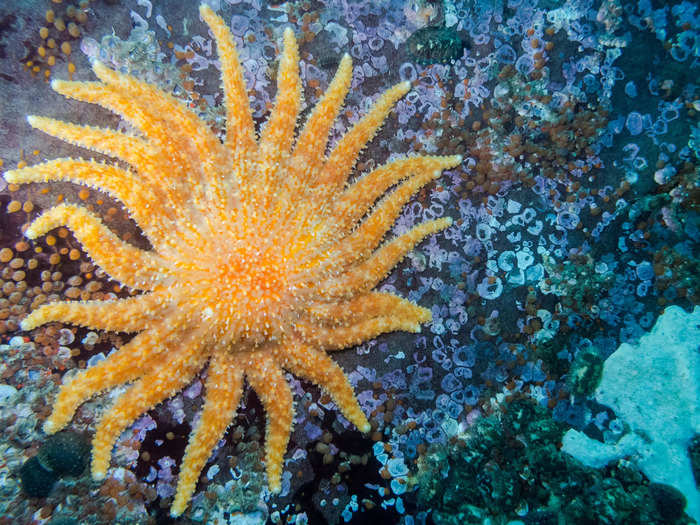
A giant sunflower star (Pycnopodia helianthoides) walks across the reef underwater in Point Dume State Beach, California.Brent Durand/Getty Images
The kelp forests found along much of the West Coast of North America are dying, but scientists think returning a once-abundant predator to the underwater ocean ecosystems could save them.
Populations of sunflower sea stars, or Pycnopodia helianthoides, have rapidly collapsed since 2013, in part due to a disease called sea star wasting syndrome that may have been worsened by warming ocean temperatures.
As the sea stars have disappeared, some of its prey has flourished. Populations of sea urchins, which feast on kelp, have since exploded, and the underwater forests have in turn been decimated. The authors of a new paper suggest the loss of the sunflower sea stars is to blame.
The study, published last month in the Royal Society, says recovering the sea star populations, either through natural means or reintroduction facilitated by humans, could control the urchin population and restore the kelp forests.
Kelp forests support a higher diversity of plants and animals than nearly every other ecosystem in the ocean, according to the National Oceanic and Atmospheric Administration. Animals that rely on the dense vegetation for protection from predators or storms include seals and sea lions, whales, otters, and birds, among others.
Meet the sunflower sea stars that scientists say could save them.








 I spent $2,000 for 7 nights in a 179-square-foot room on one of the world's largest cruise ships. Take a look inside my cabin.
I spent $2,000 for 7 nights in a 179-square-foot room on one of the world's largest cruise ships. Take a look inside my cabin. Saudi Arabia wants China to help fund its struggling $500 billion Neom megaproject. Investors may not be too excited.
Saudi Arabia wants China to help fund its struggling $500 billion Neom megaproject. Investors may not be too excited. Colon cancer rates are rising in young people. If you have two symptoms you should get a colonoscopy, a GI oncologist says.
Colon cancer rates are rising in young people. If you have two symptoms you should get a colonoscopy, a GI oncologist says. Catan adds climate change to the latest edition of the world-famous board game
Catan adds climate change to the latest edition of the world-famous board game
 Tired of blatant misinformation in the media? This video game can help you and your family fight fake news!
Tired of blatant misinformation in the media? This video game can help you and your family fight fake news!
 Tired of blatant misinformation in the media? This video game can help you and your family fight fake news!
Tired of blatant misinformation in the media? This video game can help you and your family fight fake news!

Copyright © 2024. Times Internet Limited. All rights reserved.For reprint rights. Times Syndication Service.